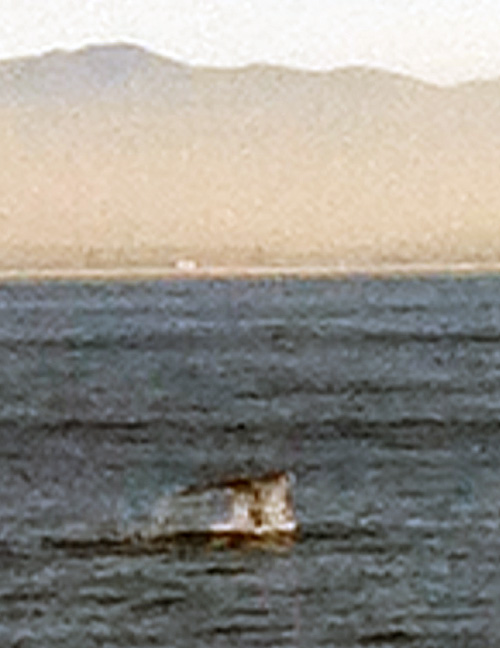
Story and photos by Shahar Masori
SAN DIEGO –Like flower girls scampering down the wedding aisle, a pair of porpoises skimmed by our Birch Aquarium-sponsored whale-watching excursion as if to announce that “she is coming! she is coming!” Sure enough, it was not long afterwards that we spotted a puff of vapor indicating that a Gray Whale was in the vicinity of our Flagship vessel.
Kate Jirik, a Birch Aquarium naturalist who narrated the media tour off San Diego’s coast on Tuesday, Jan. 8, told us that the Gray Whales began their journey in frigid Alaskan waters and between October and May would continue traveling until they reach Scammon’s Lagoon approximately midway down the Baja California peninsula. This is a round trip of approximately 10,000 miles, which is the longest annual mammal migration in the world. According to the Birch Aquarium website, over a lifetime a Gray Whale will travel the equivalent distance of a round trip to the moon.
Our own trip traced a fractional part of the whales’ route. As we came out of San Diego Bay, into the Pacific Ocean, the Coronado Islands of Mexico were ahead of us. Whales, we soon learned, would be swimming to the right and to the left of us.
“Look off to 11 o’clock!” said Jirik, suddenly interrupting her narrative. Immediately all the passengers pushed to the front left side of the boat, clicking their cameras and their cell phones trying to get a good photograph of a whale who showed only enough of her body to take a few breaths before subsiding back into the ocean.

As it turned out, whale watching was more like whale spotting. We followed the trail of the whales as they went their way. Every now and then those amazing creatures surfaced, exhaled, inhaled and dove. As they dove, a very large tail became briefly visible. And cameras clicked like crazy.
Jirik and colleagues who circulated among the media and other guests aboard, said that
approximately 20,000 gray whales make the trip annually. Pregnant females typically leave first and sometimes give birth while on the go. However most of the females will give birth in the lagoons. After birth a young calf will basically stay close to his mom drinking milk continuously, even while journeying back to the Bering Sea.
The calf will consume up to 50 gallons of milk a day, however with up to 50% fat, the consistency of the liquid is more of a cottage cheese than milk, the guides said. A young calf weighs about 1500 pounds at birth and will eventually mature to approximately 35 tons and reach a size of 45 feet.
Being mammals, whales have to surface for air. Jirik said that unlike humans who only convert about 17% of the air they breathe into a usable substance, whales can convert up to 90%. They also are able to collapse their lungs, enabling them to dive deeper.

Although some whales have teeth, the Gray Whale has its upper jaw lined with rows of baleen instead, which he uses to filter his food. Typically the Grey Whale eats amphipods which are tiny shrimp-like creatures. They are known as bottom feeders due to the unique way they feed. While on their side, using their huge tongue, they take vast amounts of mud from the sea floor and filter through it to get their food, according to a Birch Aquarium guide.
While on the boat and after spotting the first whale I couldn’t help but wonder how Jonah must have felt when faced with such an enormous creature—could Jonah’s famous big fish have been the size of a Gray Whale? I also wondered if God suddenly sent a storm, and things got rough on the boat, would this Jewish reporter feel obliged to jump first?
As we were heading back towards San Diego Bay we had the pleasure of spotting a group of about five dolphins and one sea lion swimming alongside us.
There were many volunteers From Birch aquarium who were very knowledgeable and happy to answer any question. A Jewish volunteer even helped me find a Jewish angle to this story, confiding in me that whales are not kosher.
I would recommended everyone to go and meet these amazing creatures. They are a true wonder of nature and a must-see natural phenomenon.
*
Masori is a freelance writer based in San Diego. He may be contacted at shahar.masori@sdjewishworld.com